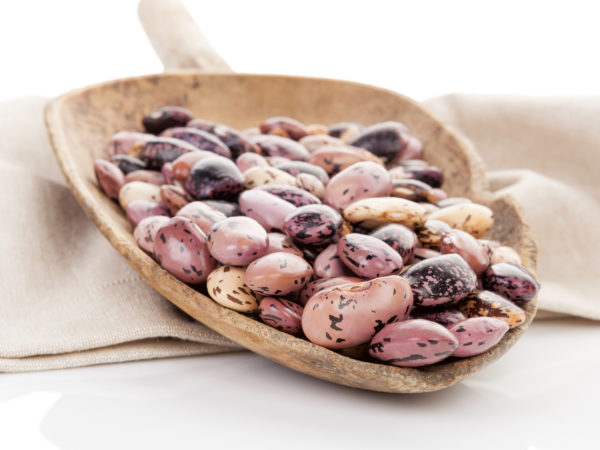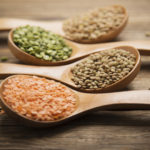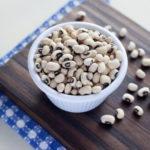Cooking With Legumes: Pinto Beans

Pinto beans, like other descendants from the “common bean” (Phaseolus vulgaris), are extremely popular legumes – especially in the Southwest, where they are most often enjoyed in the form of refried beans, along with other dishes of southwestern, Mexican and Tex-Mex cuisine. In fact, pinto beans are the most widely enjoyed beans in the United States, accounting for about 45 percent of our bean consumption.
“Pinto” is the Spanish word for painted, and accurately describes the mottled red-on-beige coloring of these legumes (though, when cooked, their speckled pattern disappears as the skins turn to pinkish-brown).
Pinto beans have a creamy texture, mild flavor and, like all beans, a robust nutritional profile. A half-cup serving has just over 100 calories, but provides seven grams of both fiber and protein. It also provides 37 percent of the Daily Value for folate, a B-complex vitamin that helps lower blood levels of homocysteine – an amino acid that, in large quantities, is associated with an increased risk of heart disease. The same amount of pintos also contains 85 percent of the Daily Value of molybdenum, a trace mineral responsible for detoxifying sulfites (preservatives commonly added to foods that can produce negative reactions in those sensitive to them) in the body.
Cooking time: 60-90 minutes
Liquid per cup of legume: 3 cups
How to cook pinto beans: Soak overnight. Drain water and replace with fresh, cold water for cooking. Place on stove and bring to a boil in a pot with a lid. Once boiling, reduce to a simmer, tilting lids slightly to allow steam to escape, and cook for up to 90 minutes, or until tender.
Try pinto beans in this recipe: Mole Pinto Beans


![Chick-peas on wooden plank
SEE MY LIGHTBOX
[url=/file_search.php?action=file&lightboxID=8604143][img]/file_thumbview_approve.php?size=1&id=15891028[/img][/url] [url=/file_search.php?action=file&lightboxID=8604143][img]/file_thumbview_approve.php?size=1&id=16870512 [/img][/url] [url=/file_search.php?action=file&lightboxID=8604143][img]/file_thumbview_approve.php?size=1&id=20010294[/img][/url] [url=/file_search.php?action=file&lightboxID=8604143][img]/file_thumbview_approve.php?size=1&id=18386560[/img][/url] [url=/file_search.php?action=file&lightboxID=8604143][img]/file_thumbview_approve.php?size=1&id=20053137[/img][/url] [url=/file_search.php?action=file&lightboxID=8604143][img]/file_thumbview_approve.php?size=1&id=15437380[/img][/url][url=/file_search.php?action=file&lightboxID=8604143][img]/file_thumbview_approve.php?size=1&id=20033140[/img][/url] [url=/file_search.php?action=file&lightboxID=8604143][img]/file_thumbview_approve.php?size=1&id=16249436[/img][/url] [url=/file_search.php?action=file&lightboxID=8604143][img]/file_thumbview_approve.php?size=1&id=19911687[/img][/url] [url=/file_search.php?action=file&lightboxID=8604143][img]/file_thumbview_approve.php?size=1&id=15503434[/img][/url][url=/file_search.php?action=file&lightboxID=8604143][img]/file_thumbview_approve.php?size=1&id=19972897[/img][/url] [url=/file_search.php?action=file&lightboxID=8604143][img]/file_thumbview_approve.php?size=1&id=13519957[/img][/url] [url=/file_search.php?action=file&lightboxID=8604143][img]/file_thumbview_approve.php?size=1&id=19922385[/img][/url] [url=/file_search.php?action=file&lightboxID=8604143][img]/file_thumbview_approve.php?size=1&id=18531542[/img][/url] [url=/file_search.php?action=file&lightboxID=8604143][img]/file_thumbview_approve.php?size=1&id=15422723[/img][/url]](https://www.drweil.com/wp-content/uploads/2016/11/diet-nutrition_cooking-cookware_cooking-with-legumes-garbanzo-beans-chickpeas_1440x1080_000015437380-150x150.jpg)










